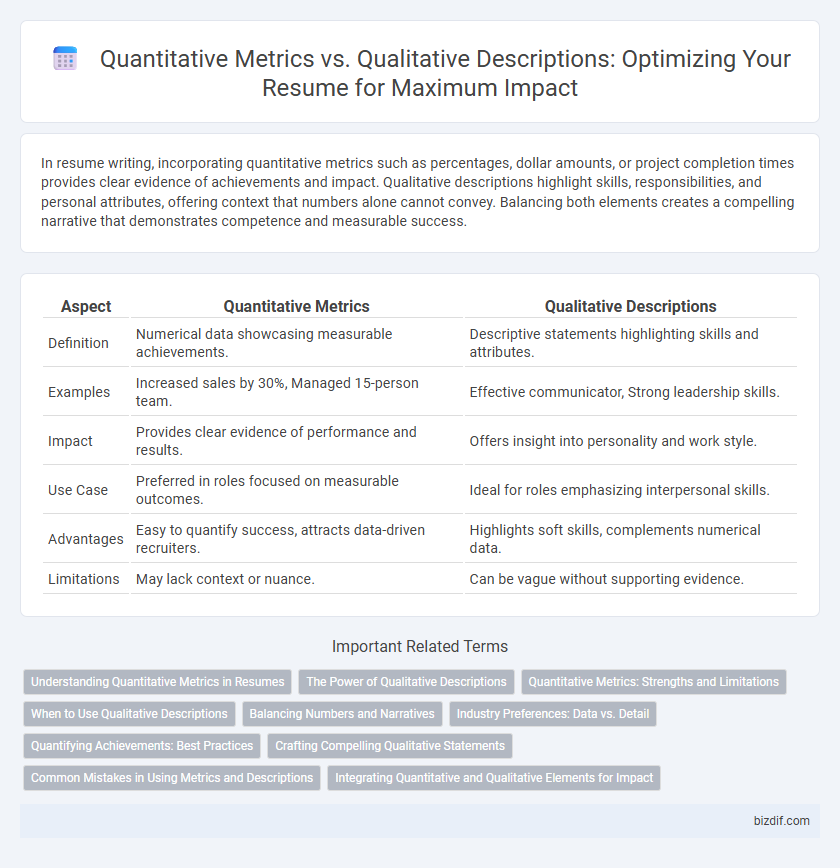In resume writing, incorporating quantitative metrics such as percentages, dollar amounts, or project completion times provides clear evidence of achievements and impact. Qualitative descriptions highlight skills, responsibilities, and personal attributes, offering context that numbers alone cannot convey. Balancing both elements creates a compelling narrative that demonstrates competence and measurable success.
Table of Comparison
| Aspect | Quantitative Metrics | Qualitative Descriptions |
|---|---|---|
| Definition | Numerical data showcasing measurable achievements. | Descriptive statements highlighting skills and attributes. |
| Examples | Increased sales by 30%, Managed 15-person team. | Effective communicator, Strong leadership skills. |
| Impact | Provides clear evidence of performance and results. | Offers insight into personality and work style. |
| Use Case | Preferred in roles focused on measurable outcomes. | Ideal for roles emphasizing interpersonal skills. |
| Advantages | Easy to quantify success, attracts data-driven recruiters. | Highlights soft skills, complements numerical data. |
| Limitations | May lack context or nuance. | Can be vague without supporting evidence. |
Understanding Quantitative Metrics in Resumes
Quantitative metrics in resumes provide clear, measurable evidence of achievements, such as increasing sales by 30% or managing a budget of $500,000, which helps employers quickly assess a candidate's impact. Using specific numbers enhances credibility and allows for easy comparison between candidates' performance. Including metrics like project completion time, revenue growth, or customer satisfaction scores strengthens the resume's effectiveness by showcasing tangible results.
The Power of Qualitative Descriptions
Qualitative descriptions in resume writing effectively convey skills and achievements by highlighting personal attributes, problem-solving abilities, and leadership qualities that numbers alone cannot capture. These narratives provide context and depth, showcasing how contributions impacted team dynamics and company culture. Incorporating compelling qualitative details complements quantitative metrics, creating a balanced and persuasive presentation of professional expertise.
Quantitative Metrics: Strengths and Limitations
Quantitative metrics in resume writing provide clear, measurable evidence of achievements, such as percentages, revenue growth, or project completion rates, which help employers quickly assess candidate impact. These metrics enhance credibility by showcasing specific results and driving data-driven evaluations, yet they might oversimplify complex skills or overlook intangible qualities like leadership and creativity. Balancing quantitative data with contextual explanations ensures a comprehensive presentation of professional strengths and potential contributions.
When to Use Qualitative Descriptions
Use qualitative descriptions on a resume when demonstrating soft skills, such as leadership, creativity, or teamwork, that cannot be easily quantified. Emphasize personal attributes and contextual achievements to provide a nuanced understanding of your professional impact. Qualitative descriptions are particularly effective in industries where interpersonal abilities and adaptability are critical to job performance.
Balancing Numbers and Narratives
In resume writing, balancing quantitative metrics with qualitative descriptions enhances the impact by showcasing both measurable achievements and contextual skills. Incorporating specific numbers, such as percentage increases or revenue growth, offers concrete evidence of success, while compelling narratives illustrate problem-solving abilities and leadership qualities. This integration creates a dynamic resume that appeals to applicant tracking systems and hiring managers alike.
Industry Preferences: Data vs. Detail
Employers in tech-driven industries prioritize quantitative metrics to measure achievements clearly, such as percentage increases in sales or exact cost reductions. Creative sectors value qualitative descriptions that highlight problem-solving skills, leadership influence, and project storytelling to convey impact. Tailoring resumes to industry preferences by combining specific data points with illustrative details enhances candidate appeal.
Quantifying Achievements: Best Practices
Quantifying achievements with specific numbers, percentages, or measurable outcomes enhances resume impact by providing clear evidence of success. Using metrics such as sales growth, cost savings, or project completion rates enables hiring managers to quickly assess performance and value. Best practices include aligning metrics with job requirements, maintaining accuracy, and avoiding vague descriptions to ensure clarity and relevance.
Crafting Compelling Qualitative Statements
Crafting compelling qualitative statements in resume writing emphasizes showcasing interpersonal skills, leadership qualities, and problem-solving abilities that numbers alone cannot capture. Highlighting specific examples of collaboration, innovation, and adaptability adds depth to your professional narrative, making your contributions relatable and memorable. Integrating vivid, outcome-focused language enhances the impact of qualitative descriptions, complementing quantitative metrics to present a well-rounded candidate profile.
Common Mistakes in Using Metrics and Descriptions
Common mistakes in using quantitative metrics in resume writing include relying on vague numbers without context or using outdated statistics that fail to demonstrate current impact. Overemphasis on qualitative descriptions often results in generic statements lacking measurable achievements, making it difficult for recruiters to assess actual performance. Balancing precise, relevant metrics with clear, impactful narrative enhances credibility and effectively conveys professional accomplishments.
Integrating Quantitative and Qualitative Elements for Impact
Integrating quantitative metrics and qualitative descriptions in a resume enhances impact by providing measurable achievements alongside context and personal attributes. Quantitative metrics such as percentage increases, revenue growth, or project completions validate accomplishments with clear data. Qualitative elements like leadership skills, problem-solving abilities, and innovative contributions create a compelling narrative that complements these metrics for a well-rounded profile.
Quantitative Metrics vs Qualitative Descriptions Infographic

 bizdif.com
bizdif.com